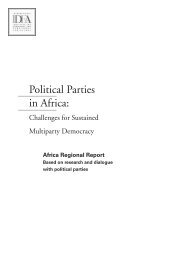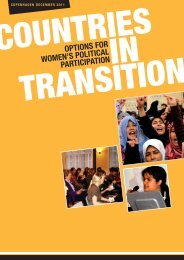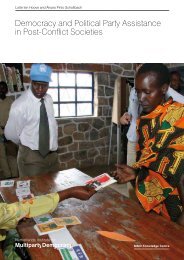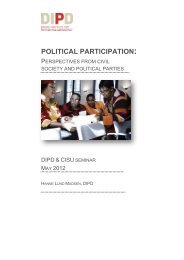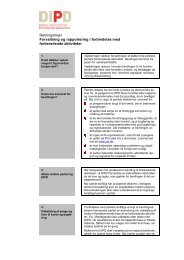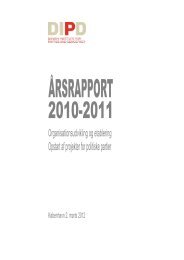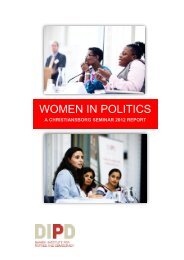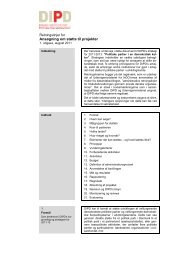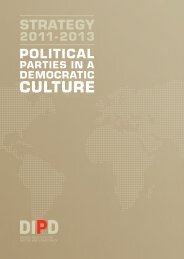Background Document - Danish Institute for Parties and Democracy
Background Document - Danish Institute for Parties and Democracy
Background Document - Danish Institute for Parties and Democracy
You also want an ePaper? Increase the reach of your titles
YUMPU automatically turns print PDFs into web optimized ePapers that Google loves.
INSTITUTIONALISED MALE DOMINANCE AND PRIVILEGE<br />
Everywhere in the world, it is evident that political transitions are gendered <strong>and</strong> their<br />
outcomes ultimately reflect the different social meanings attributed to men <strong>and</strong> women.<br />
Hence, the unequal participation <strong>and</strong> representation of women <strong>and</strong> men is evident<br />
in the predominance of men among the leaders of political parties or movements, parliamentarians,<br />
cabinet ministers <strong>and</strong> heads of governments <strong>and</strong> states.<br />
In most countries, although not in all, women <strong>and</strong> men have equal rights to vote<br />
<strong>and</strong> to st<strong>and</strong> <strong>for</strong> elective positions. After at least 40 years of struggle, Kuwaiti women<br />
gained comprehensive political rights in 2005. In 2003 in Oman <strong>and</strong> Qatar, women were<br />
granted the right to vote <strong>and</strong> to st<strong>and</strong> <strong>for</strong> parliamentary office <strong>for</strong> the first time.<br />
Currently women make up only 19% of the parliaments of the world. 4 Why, then are<br />
there so few women in elective positions of power <strong>and</strong> decision making at all levels? Why<br />
is that political transitions keep producing <strong>and</strong> reproducing men as leaders in higher<br />
proportions to women?<br />
To illustrate the point, despite the promising start to the year, according to the Inter<br />
Parliamentary Union by the end of 2011, women represented only 10.7% of parliamentarians<br />
in the Arab region. The Arab region remains the only one in the world without<br />
any parliament that has at least 30% representation of women.<br />
However, it is worthy to note that a number of countries in the Arab region have<br />
introduced quotas to improve the political participation <strong>and</strong> representation of women,<br />
in the face of political, cultural, religious, economic <strong>and</strong> institutional factors that pose<br />
particular challenges to women in this region. For example, in Morocco, following the<br />
2011 elections <strong>and</strong> in accordance with a bill passed by the Council of Ministers on 9 September<br />
2011, women now constitute 16.7% of Morocco’s Lower House <strong>and</strong> this is largely<br />
due to the reservation of 60 seats <strong>for</strong> women <strong>and</strong> 30 <strong>for</strong> c<strong>and</strong>idates under the age of 40.<br />
In Tunisia, the political parties participating in the October 2011 elections were required<br />
to include women in their electoral lists in strict alternation. In theory, this was<br />
a strong affirmative measure, but in practice, most of the more than 80 parties contesting<br />
the elections (with more than 1,500 lists registered) won only one seat in any one<br />
constituency, which went to the male c<strong>and</strong>idate invariably heading the list. In Libya, the<br />
adopted Election Law stipulates that the General National Congress (constituent assembly)<br />
would be composed of 200 members elected freely <strong>and</strong> directly, <strong>and</strong> requires parity<br />
on party lists <strong>for</strong> 80 of these seats.<br />
In Egypt, however, the new law on the Exercise of Political Rights amended the previous<br />
quota <strong>for</strong> women, which used to allocate 64 seats (or 12%) in the parliament to<br />
women. The amended law required each political party to include one woman on their<br />
c<strong>and</strong>idate list, but did not require the positioning of women in “winnable” slots – each<br />
party has the freedom to decide where to allocate the name of the woman c<strong>and</strong>idate,<br />
even at the bottom of the list. This has ultimately resulted in a decrease in the number<br />
of seats held by women be<strong>for</strong>e the revolution <strong>and</strong> democratic uprising, with only 10<br />
women out of 508 members (2%).<br />
MOBILISATION OF WOMEN AS WOMEN<br />
In any political transition process, a key question is why women choose to organise or<br />
not to organise in the different contexts. It is important to pose this question because it<br />
points to the reality of the diversity among women <strong>and</strong> the absence of a homogenous<br />
“category” of women who are not differentiated by class, religion or ethnicity.<br />
Equally important is the fact that not all women may have women’s strategic interests<br />
on the top of their agenda during trans<strong>for</strong>mative transitional processes. It can be<br />
argued that women’s exclusion is due in part to the significant social <strong>and</strong> ideological differences<br />
among women as well as to the dynamics of social mobilisation in transitional<br />
processes.<br />
4 http://www.quotaproject.org/aboutQuotas.cfm<br />
See Women in Parliament in 2011-The Year in Perspective, Inter-Parliamentary Union.<br />
WOMEN IN POLITICS DANISH INSTITUTE FOR PARTIES AND DEMOCRACY PAGE 41



